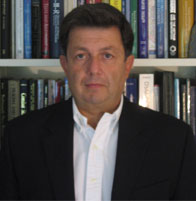Recognizing Post-Traumatic Stress Disorder in Children
Philip Saigh, Professor of Psychology and Education, has conducted 35 years of research and clinical interactions with traumatized youth, work that began during the nine years he spent at the American University of Beirut. Following the school shootings in Newtown, Connecticut, he shares his knowledge of the long-term effects of trauma exposure.
Philip Saigh, Professor of Psychology and Education, has conducted 35 years of research and clinical interactions with traumatized youth, work that began during the nine years he spent at the American University of Beirut. He served on the committee that drafted the criteria for post-traumatic stress disorder (PTSD) for the Diagnostic and Statistical Manual (DSM), and currently holds joint appointments at Bellevue Hospital and the New York University School of Medicine.
I know that many people are justifiably concerned about the long-term effects of trauma exposure given the events in Connecticut.
So let’s start with the good news: In a range of studies, while children frequently evidenced fear, nightmares, and disorganized behavior immediately after a traumatic incident, the overriding majority did not develop PTSD or long-term psychological problems.
Second – let’s establish some clear definitions.
Psychological trauma results from direct exposure to a life-threatening event – being shot, beaten very badly, being sexually assaulted, being in a serious motor vehicle accident. You have to be right there, and it has to happen to you. There can be permutations on that: People who were on the street directly in front of the World Trade Center when the towers collapsed were definitely exposed to a traumatic event.
Post-traumatic stress disorder is a disorder which may develop after exposure to a life-threatening event. Typically, symptoms need to persist or present at least 30 days after that event to warrant concern or intervention.
In children, symptoms of PTSD may include:
- Disturbing thoughts and nightmares about the trauma
- Diminished interest in activities they normally enjoy.
- Inability to sleep; sudden anger; inability to concentrate.
- Hyper-vigilance. People with post-traumatic stress disorder are always watching for danger – their antenna are way up.
- Numbing symptoms – avoidance of places that remind them of the trauma. Vietnam veterans may avoid Asian neighborhoods, for example.
- Functional academic and social impairments – including significantly compromised performance in school.
It is important to ensure that traumatized children are carefully examined for PTSD. Fortunately the disorder is highly treatable, and early case identification and intervention may offset serious psychological and academic problems among cases meeting criteria for the disorder.
A number of factors have been identified that can either increase or mitigate the risk of developing PTSD:
- Intensity of the Stressor. Most of the studies I have reviewed reported that PTSD prevalence increases as a function of the severity of stress exposure.
- Time Between Trauma Exposure and Evaluation. Almost all of the literature indicates that the prevalence of PTSD decreases over time.
- Type of Traumatic Incident. Generally speaking, sexual assault and physical assault were associated with a higher prevalence of PTSD.
- Duration of Trauma Exposure and Number of Traumas Are Predictive. Traumatic incidents that lasted for a long period of time had a higher prevalence. Multiple traumas were associated with higher prevalence.
- Prior History of Traumatic Experiences was Predictive. People who have previously been exposed to trauma are likelier to develop PTSD after subsequent traumatic exposure.
- Resettlement Stress was Predictive. Material loss was associated with more psychological distress.
- Parental Psychopathology was Predictive. Children from families with a history of psychological problems were at greater risk.
The National Institute of Mental Health has developed a set of parent and adult guidelines for helping recently traumatized youth:
- Adults should listen to their children and not judge how they are feeling or try to change their feelings.
- Adults should give children time to recover and not force them to talk about the recent traumatizing event.
- Adults should be aware that it takes time for children to heal.
- Adults should be aware of and attend to sudden changes in the child's behavior, language and emotional states.
- Adults should encourage consistency. Maintain routines. Sudden moves or changes should be avoided.
- Adults should be with their child and demonstrate love and support.
- Adults should not discourage strong emotional reactions, such as crying.
What is the treatment for PTSD?
The most effective treatment – but one that must be very carefully administered, under the right conditions, and only with the consent of parents and children – is called exposure treatment.
Essentially, the therapist slowly and gradually asks the child to imagine the traumatic event. The idea is to expose the child to the feared situation in his or her imagination, under controlled conditions. It’s like getting back on the horse after being thrown. The process requires multiple sessions of education, exposure, discussion, and the correction of wrong assumptions. I generally do not recommend this treatment unless a child has been symptomatic for at least six months, as it upsets people to relive traumatic experiences.
If a child doesn’t want to talk about an event, it’s important to respect his or her wishes. If children want to talk, encourage them to do so and be supportive. But the first rule of thumb in responding to a child who has been traumatized is: Do no harm. Forcing recently traumatized people to talk about their experiences may not be a very good idea.
Published Wednesday, Dec. 19, 2012
